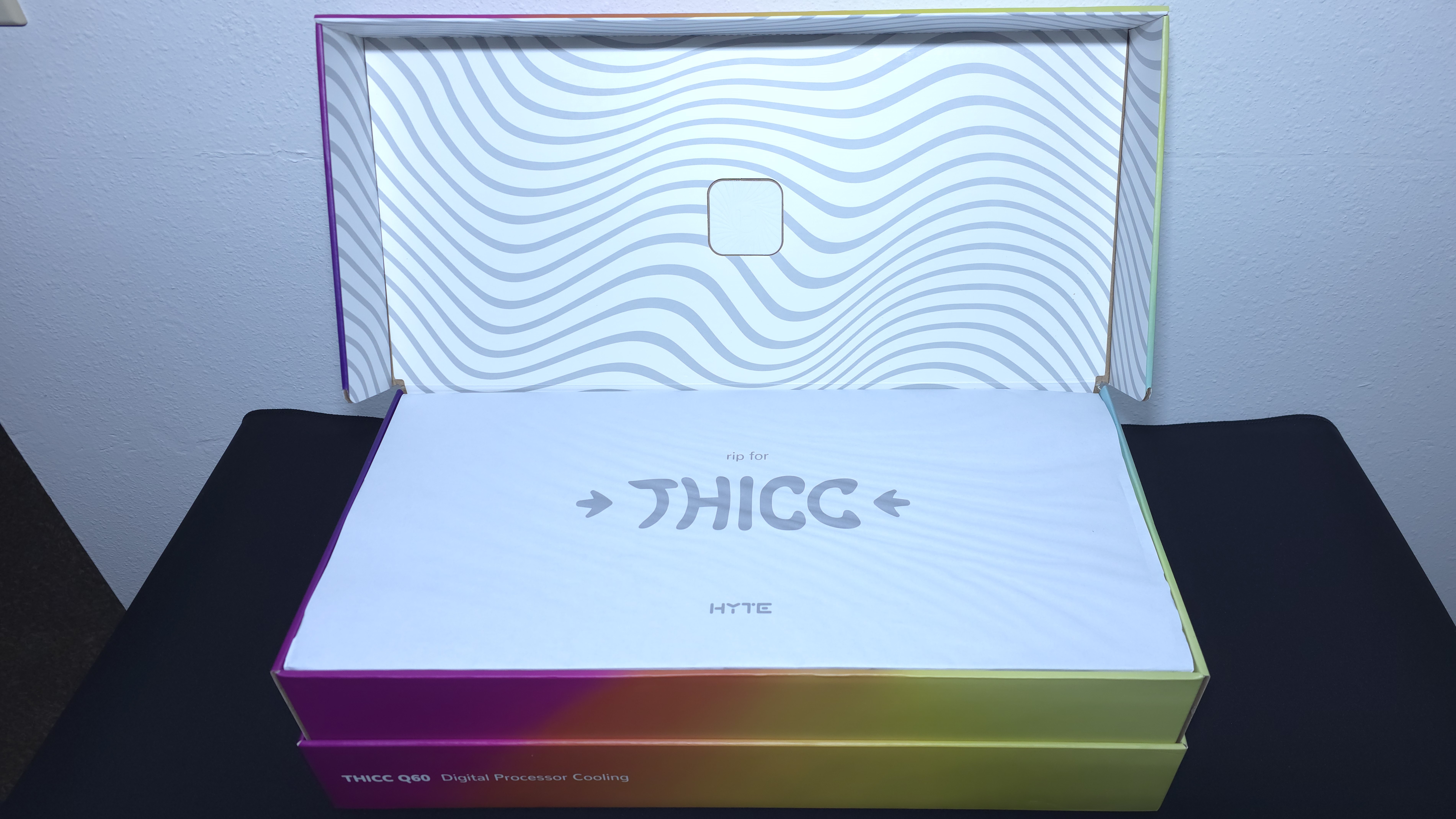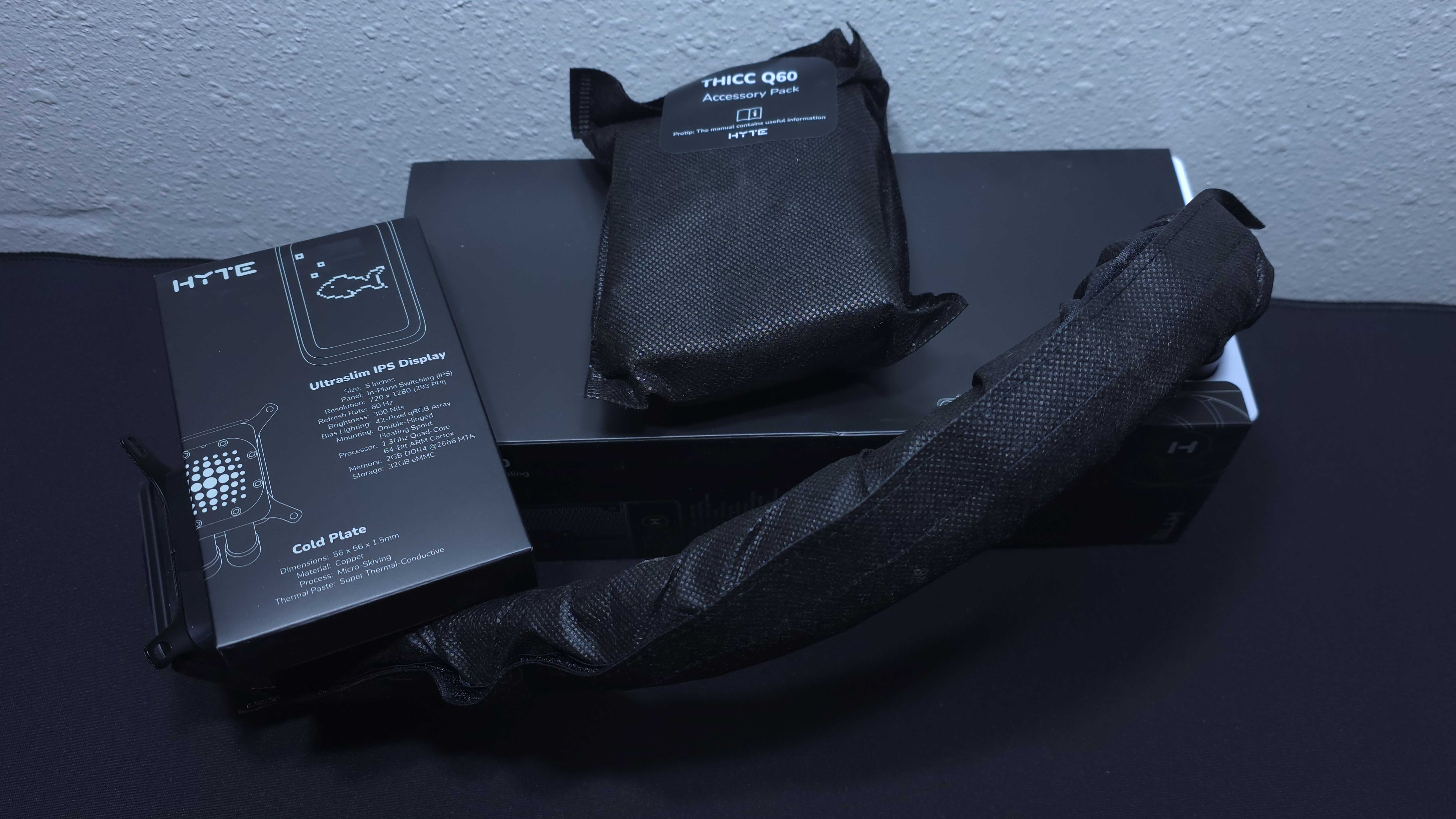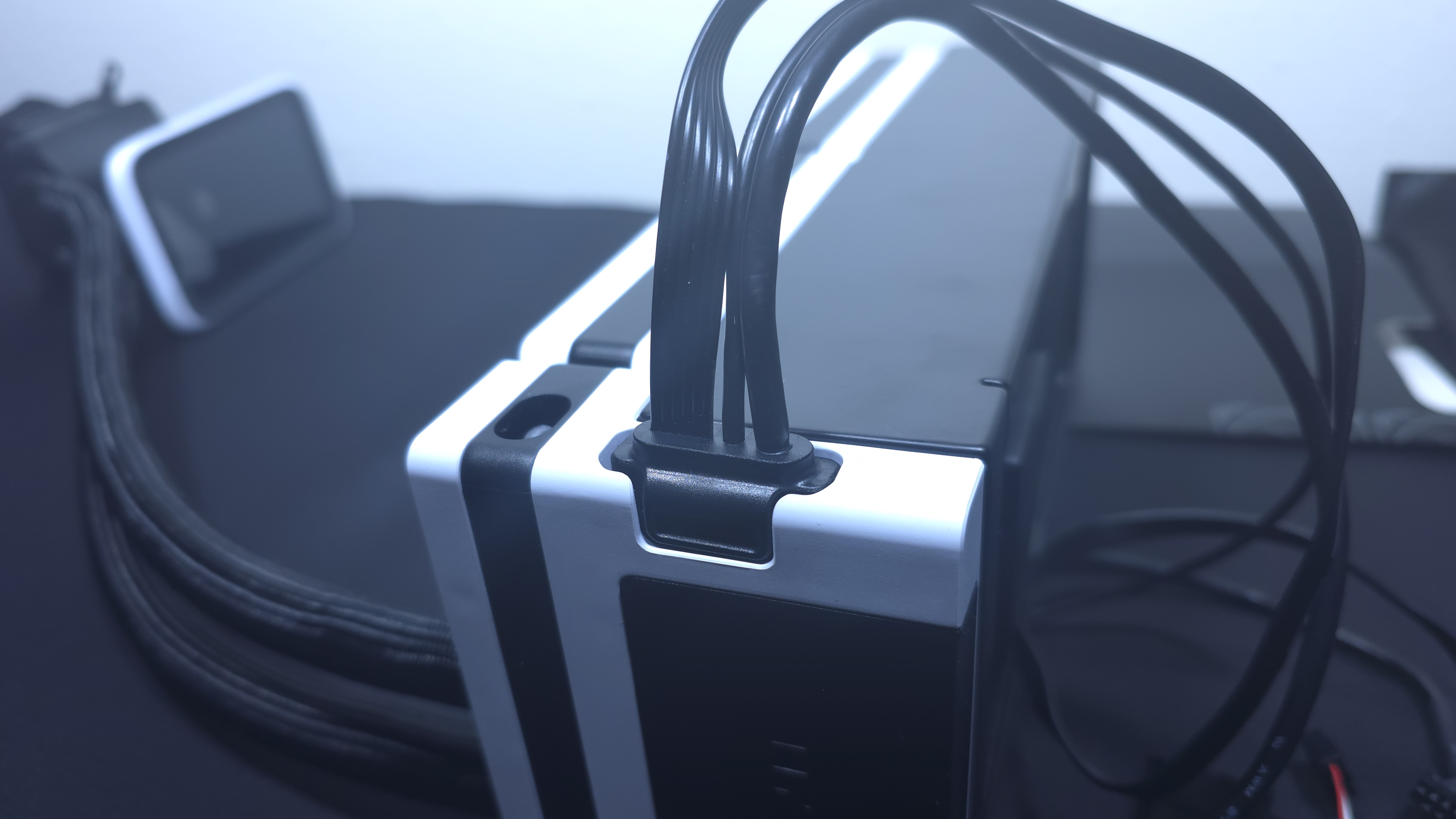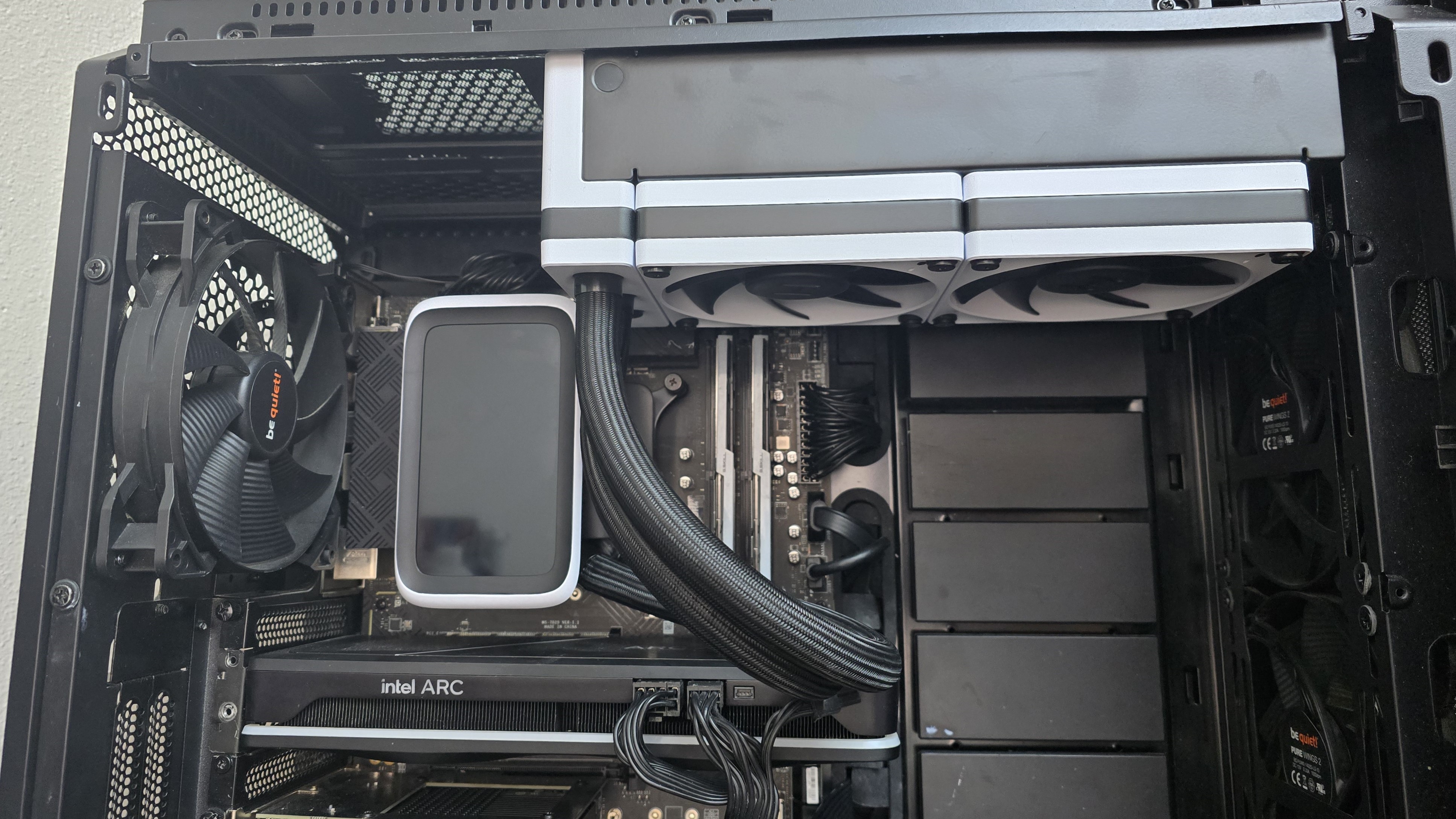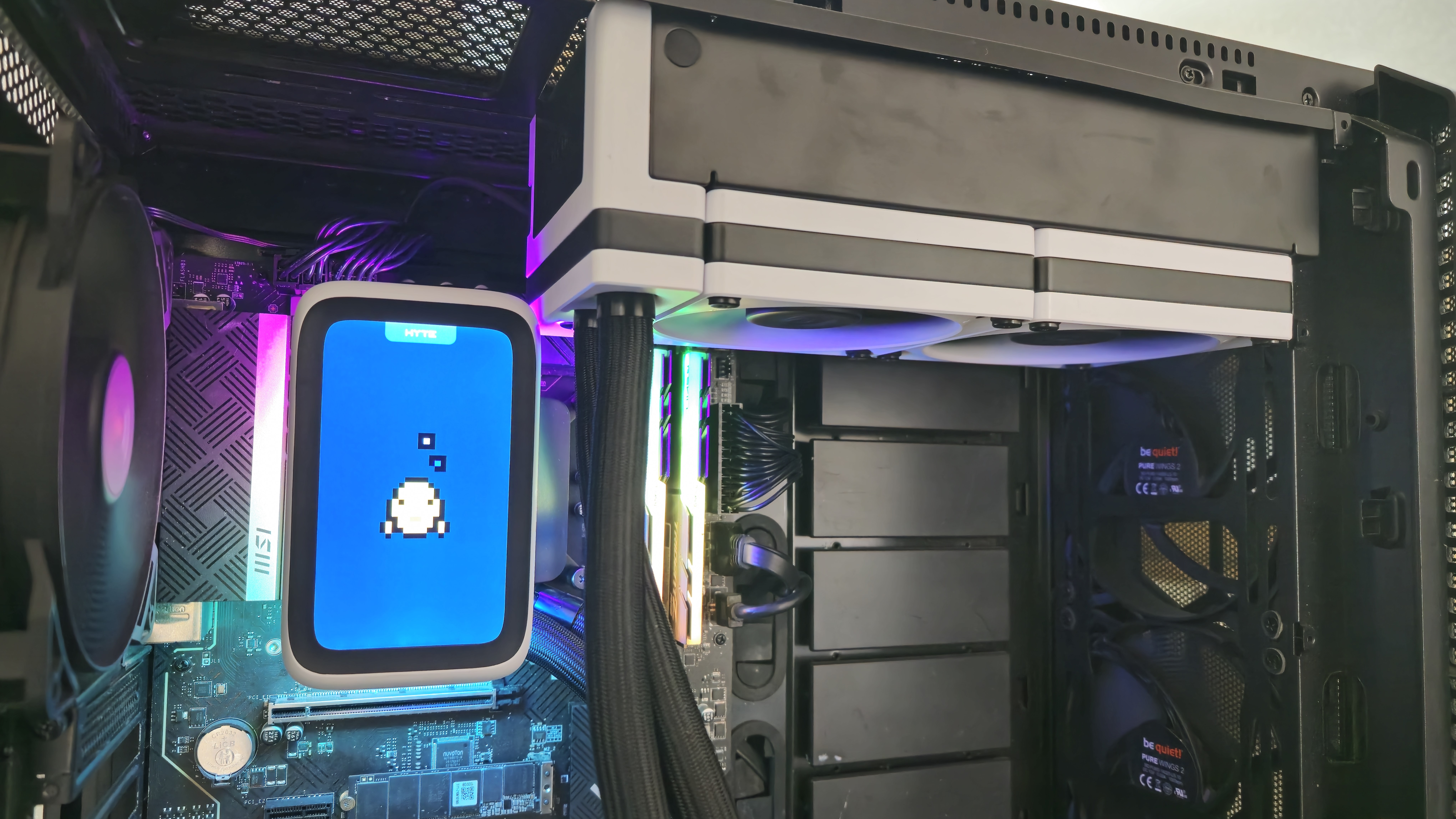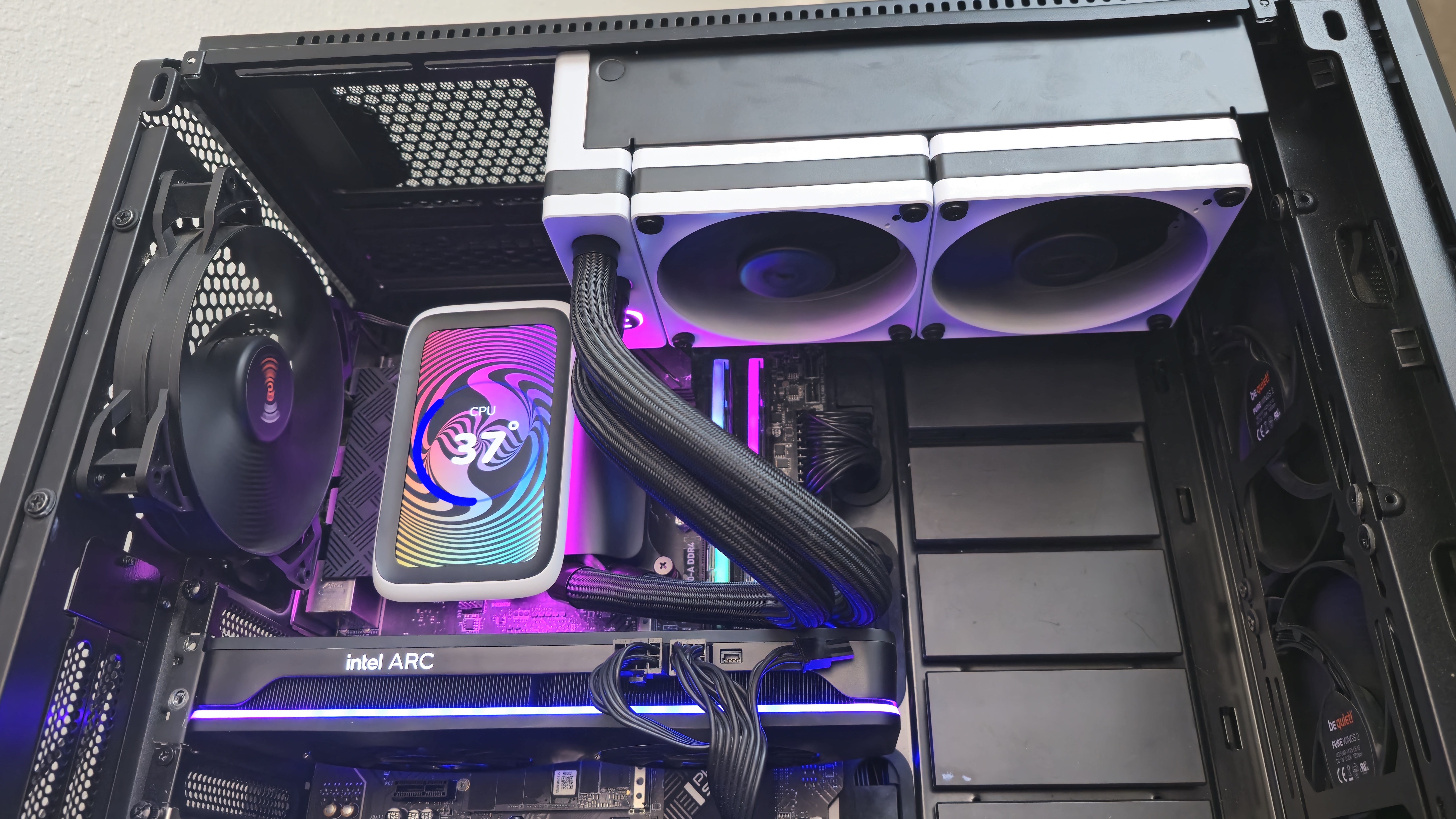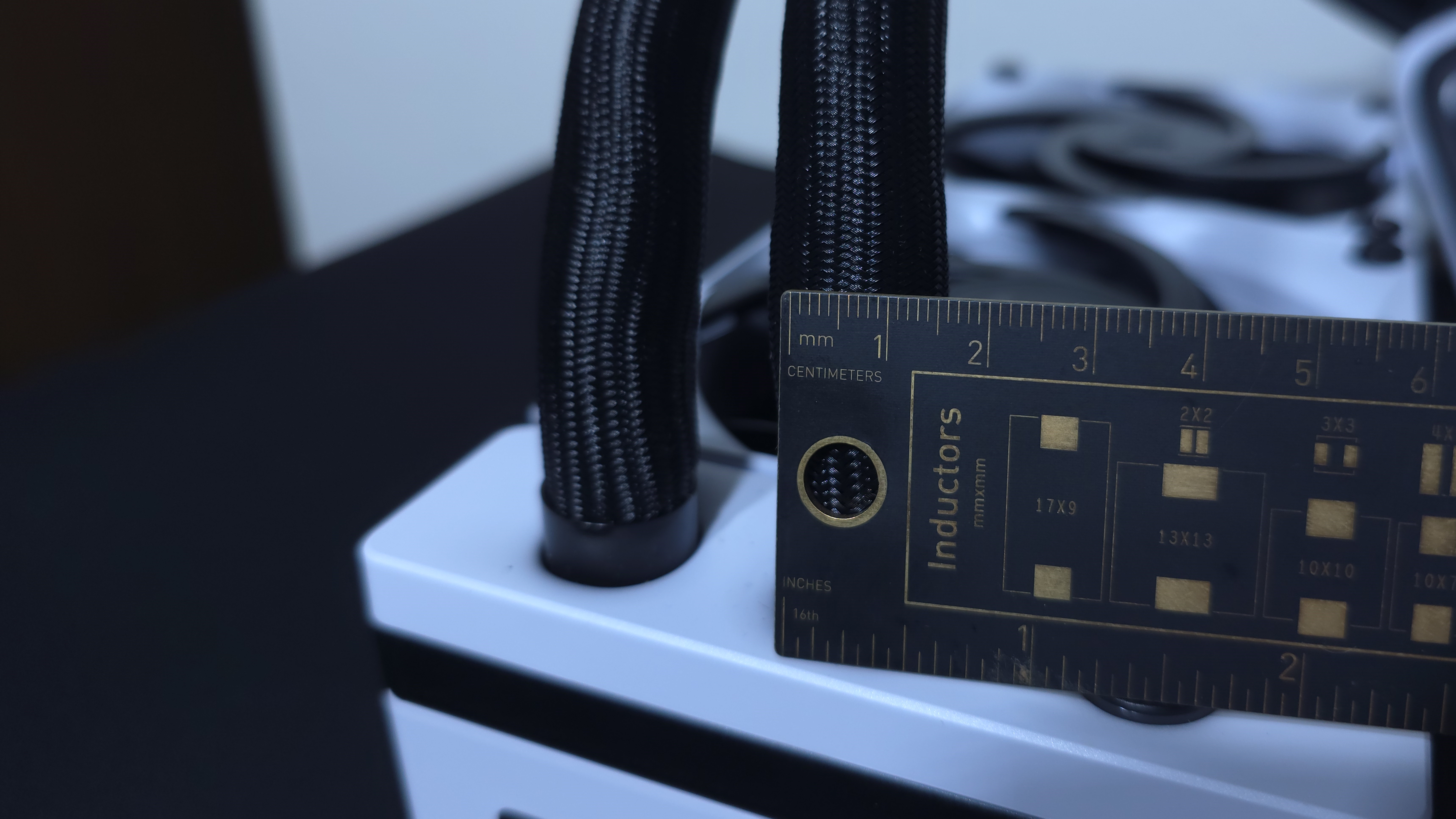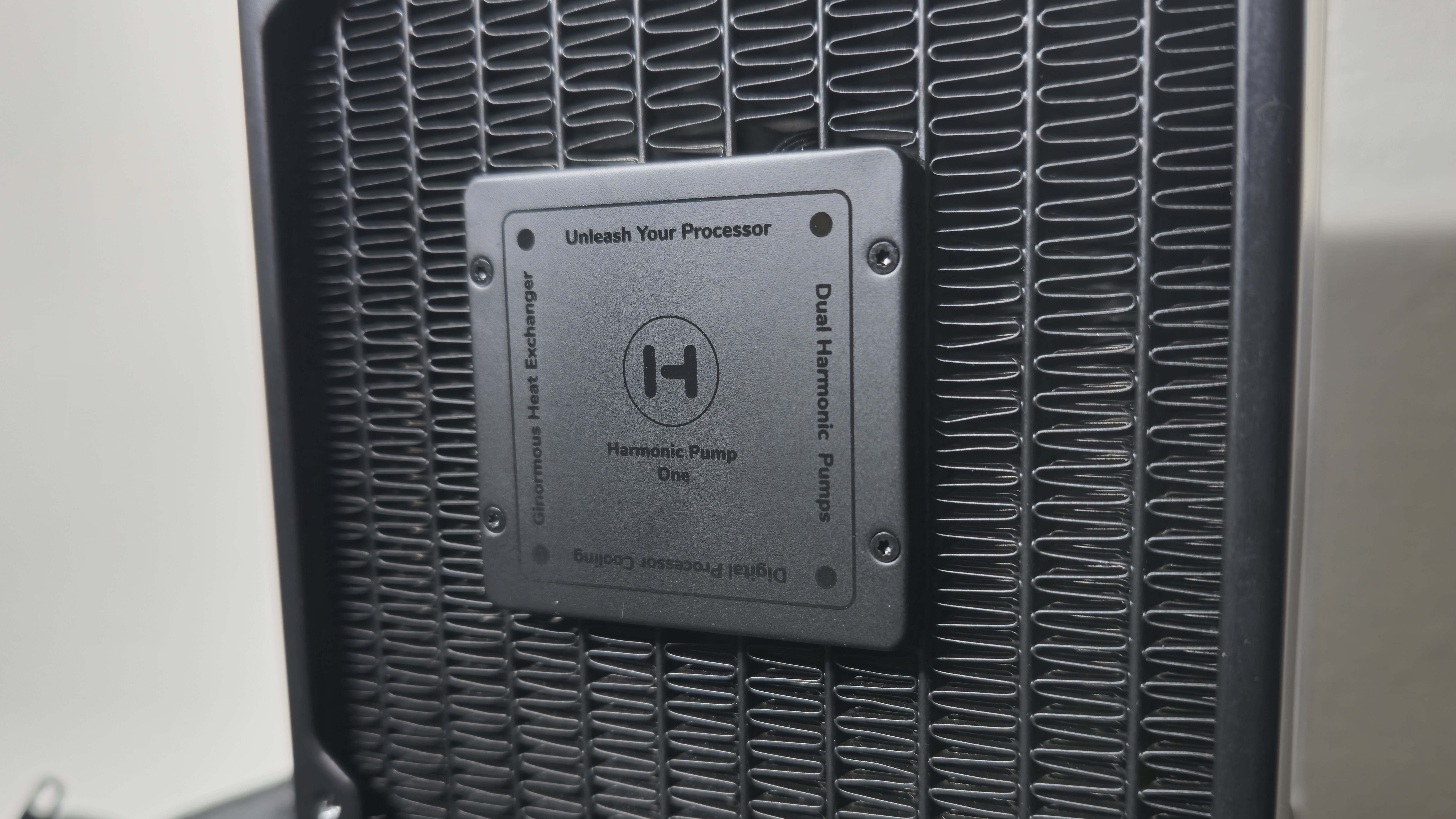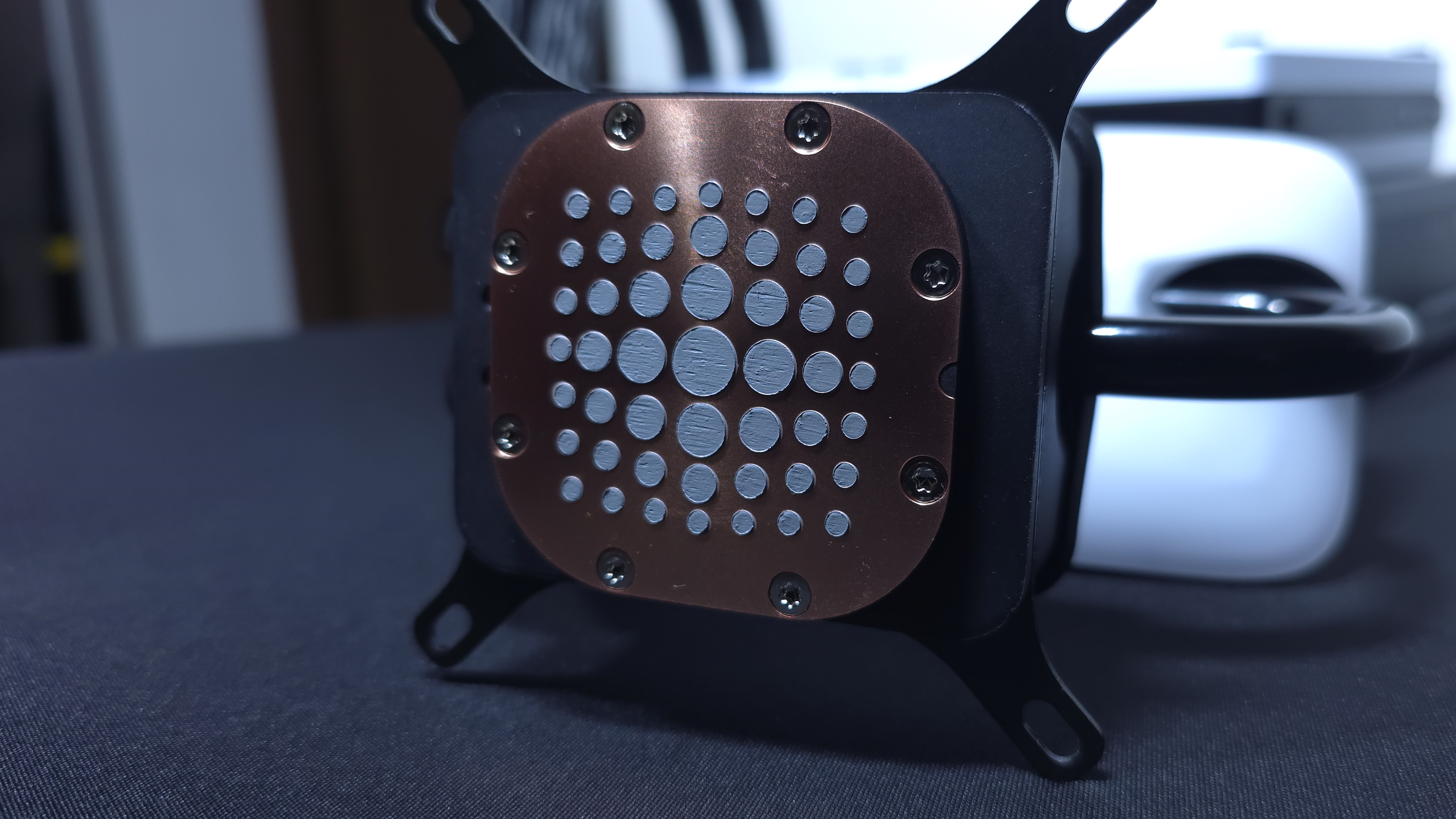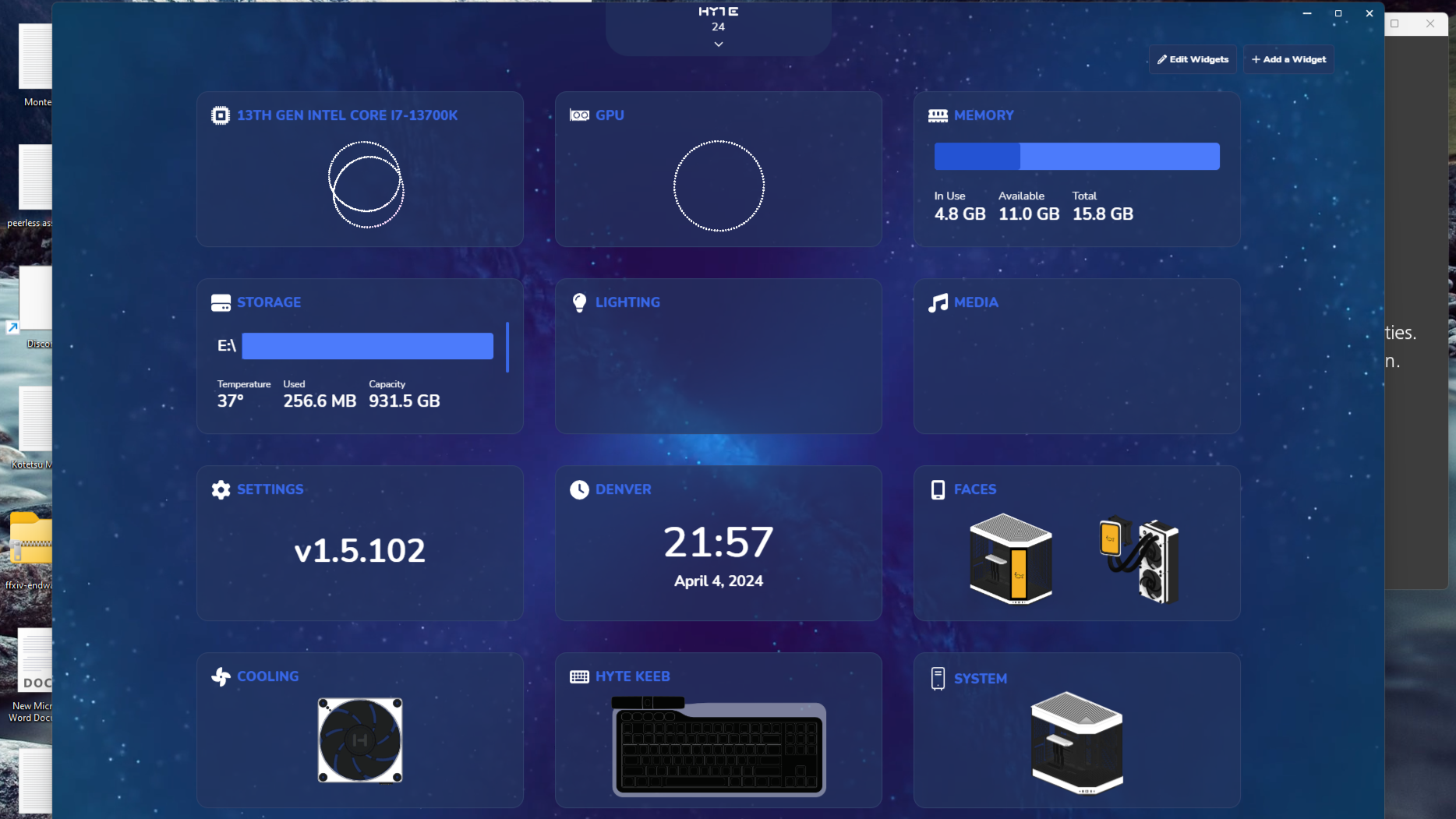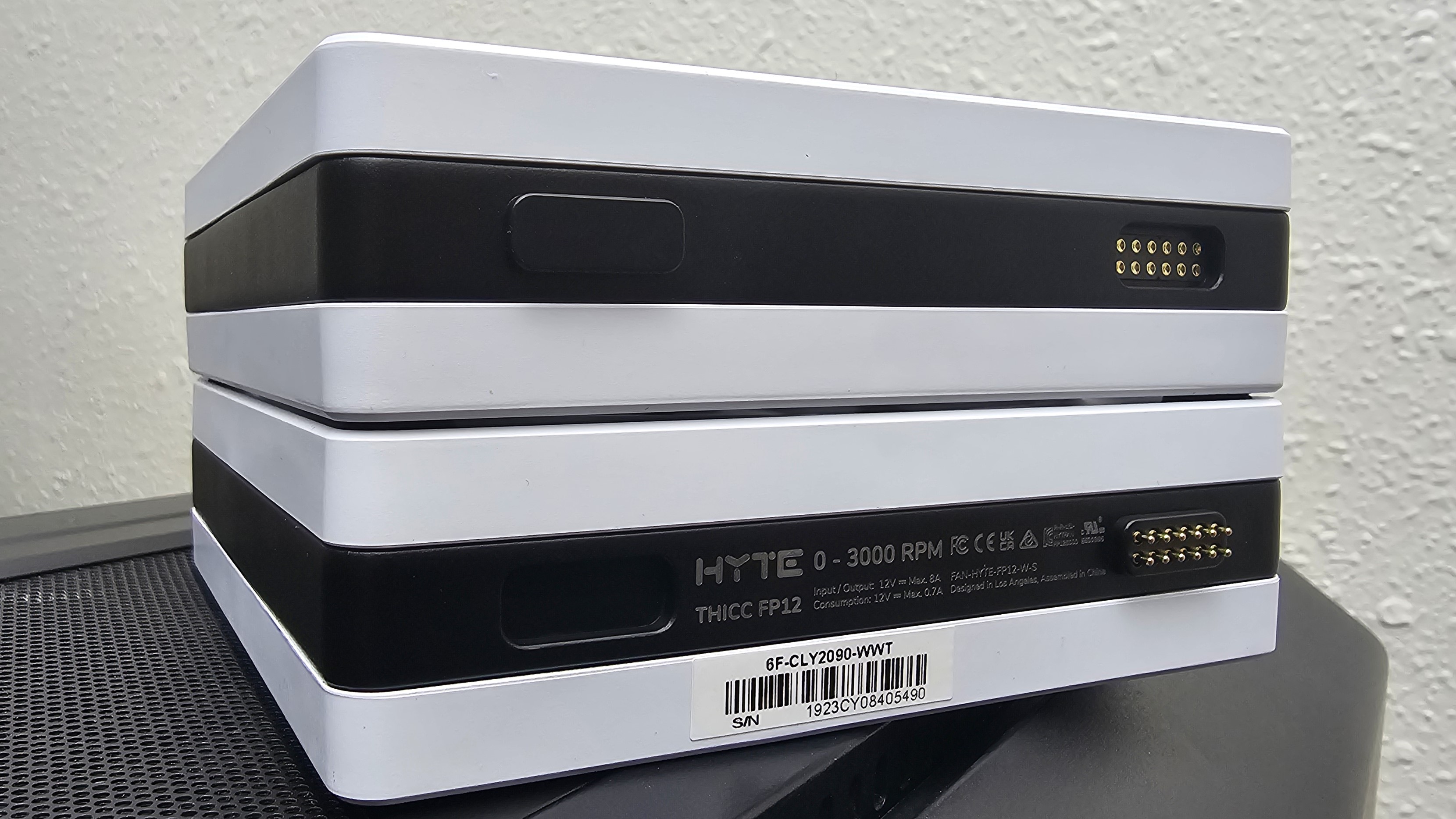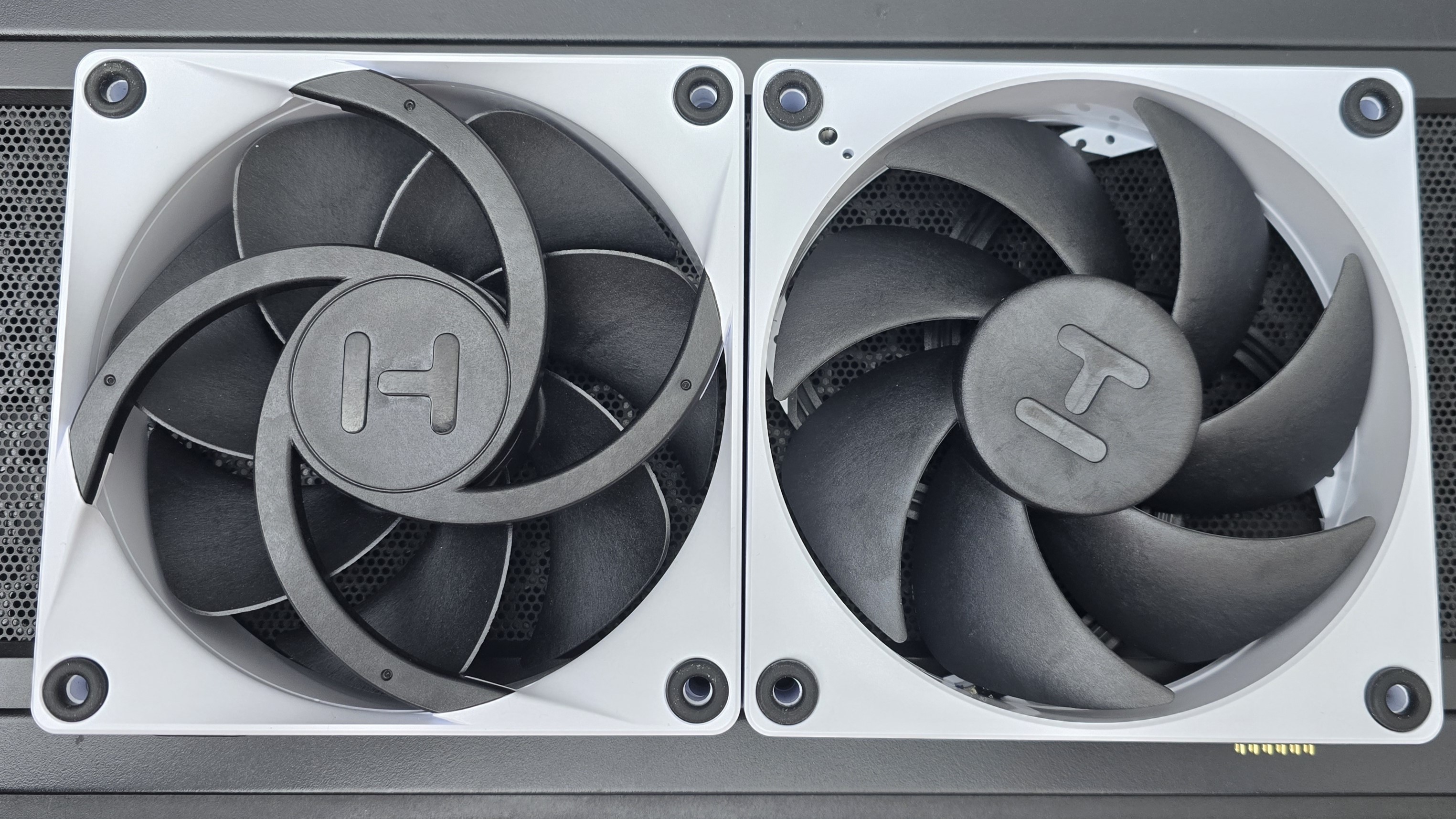Tom's Hardware Verdict
Hyte’s THICC Q60 is, hands-down, the best AIO on the market in every performance metric. But you might not be able to fit it inside your case, and it’s very expensive.
Pros
- +
Stronger cooling performance than most 360mm AIOs
- +
Chart-topping noise normalized performance
- +
The quietest AIO I’ve ever tested
- +
Default behavior avoids bursty fan noise
- +
Impressive software suite offers lots of customization options
Cons
- -
Expensive at $299
- -
Compatibility issues due to bulky design
Why you can trust Tom's Hardware
Hyte, a sister brand to IBUYPOWER, is generally known for its aesthetically focused PC cases. But the company also makes peripherals like keyboards and desk pads.Today we’ll be testing what I consider to be the most exciting liquid cooler to enter the market in years: Hyte’s THICC Q60 240mm AIO liquid cooler. We first saw this cooler last summer at Computex, and it was clear from the get-go that this was far from your average 240mm AIO.
In the Scots language, hyte means raving mad – and some might say that description aptly applies to this cooler. True to its branding, the THICC Q60 is larger and thicker than the competition in every way. The radiator and liquid tubing are twice as thick as competitors, and the fans are 32mm instead of the traditional 25mm thickness. And that’s just the beginning. We haven’t even discussed the 5-inch IPS display attached to the CPU block.
With its THICC dimensions, we expect Hyte’s THICC Q60 has a chance to land on our best AIO coolers list. But at $299 in the US, this cooler really needs to be in a class of its own to earn a strong recommendation. We’ll cover the benchmarks shortly, but first let’s look at this cooler’s specifications and features.
Cooler specifications
| Cooler | Hyte THICC Q60 |
| MSRP | $299.99 |
| Heatsink Material | Aluminum |
| Socket Compatibility | Intel Socket LGA 115x/1200/1700/2011*/2066* AMD AM5 / AM4 / TR4* *Requires optional bracket obtained via customer support |
| Base | Copper |
| Pump Impeller Diameter | 24mm |
| Pump Speed | 2000-4500RPM |
| Display | 5” 720x1280 IPS, 60hz, 300 nits |
| Max TDP (Our Testing) | >250W with Intel’s i7-13700K |
| Installed Size (with fans) | 288mm (L) x 84 mm (W) x 120mm (D) |
| Processor | Quad-core 64-bit ARM Cortex @ 1.3ghz Graphics @ 500mhz 32-bit Cortex-M4 Co-processor |
| RAM | 2GB DDR4 @ 2666 MT/S |
| Storage | 32GB eMMC |
| Warranty | 6 years |
Packing and included contents

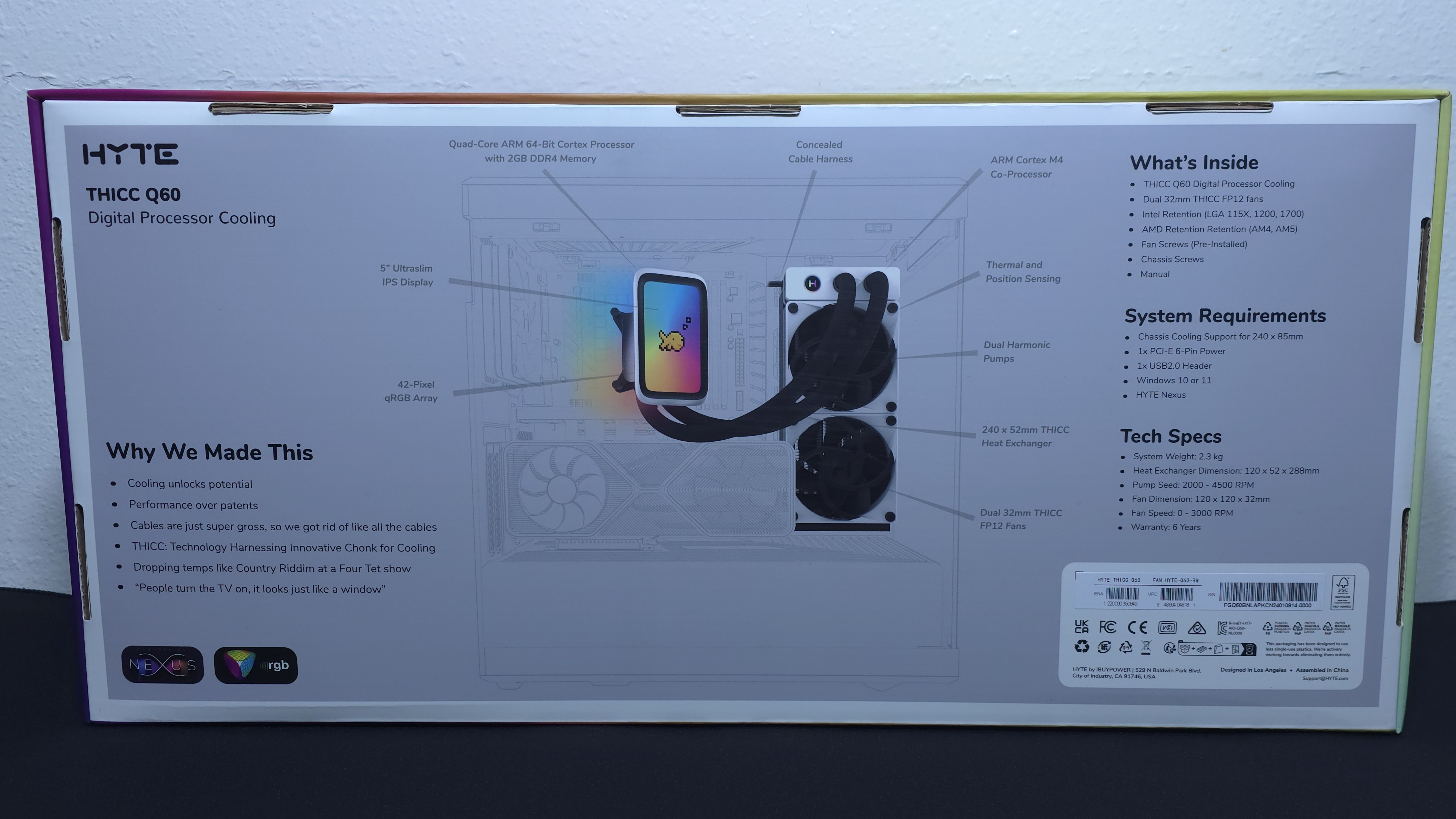
The packaging for the Hyte Q60 is a bit fancier than what comes with most AIO liquid coolers, reflecting its premium price. The imagery on the front in particular would be best described as psychedelic.
To get to the cooler, you’ll have to rip off the paper cover.
In addition to the molded cardboard frame, the cooler is also wrapped in black cardboard, with information about the cooler printed on it, as well as coverings to protect it during shipping.
The accessories and mounting equipment are stored in small cloth covering bags.
Get Tom's Hardware's best news and in-depth reviews, straight to your inbox.
LGA 1700 installation
The installation of the cooler isn’t hard in theory, but you’ll have to keep compatibility in mind due to its extra girth and thickness. You may have compatibility issues with certain motherboard sizes, due to extra large VRM heatsinks or RAM configurations – or even if you have an extra large cable management bar. In many cases, the AIO simply won’t fit if you try and mount it up top. Hyte expects that most users will install this AIO in a front or side-mounted configuration.
Hyte offers up a list of available configurations (PDF link here) that are officially supported for about 90 modern PC cases, which will be helpful for those considering this cooler. But to my surprise, the very configuration I tested the THICC Q60 in was listed as unsupported! When I asked Hyte about this, they said they listed many configurations as “no” because certain motherboards – mainly mITX SFF motherboards – might require a USB 2.0 extension cable in order to connect properly. I’ve suggested that they update the list to clarify when a case will be compatible as long as a standard-sized ATX motherboard is used.
1. The first thing you’ll want to do when installing the Q60 is to plug the connection cable to the radiator. If you’re intending to install this AIO in a top-mounted configuration, you’ll need to remove and reinstall the fans facing the opposite direction. I’d recommend mounting the radiator to your case at this point.
2. Press the motherboard against the backplate, and then secure it using the included metal standoffs.
3. Place the LCD block on top of your CPU and secure it using the included thumbscrews. You’ll want to ensure the LCD is facing upright, as the screen does not support a landscape orientation at this time.
4. Finally, make sure to connect the ends of the connector cable as appropriate. Once complete, power on your computer.
Features of Hyte’s THICC Q60 240mm AIO
▶ True to its name, everything is THICC
Every part of this AIO comes with proportions that are larger than its competitors. The fans, tubing, and radiator are all much thicker than the competition.
▶ 52mm-thick radiator, 32mm fans
The radiator included with the liquid cooler is a whopping 52mm wide, twice as thick as most AIOs currently on the market. The fans included are 32mm thick, instead of the standard 25mm-thick fans included with most coolers. Combined, that’s an unheard-of 84mm of total thickness.
▶ Thick liquid tubing
How quickly coolant travels through a loop is the most important factor that influences the performance of a liquid cooler. Most manufacturers have opted to push for faster and faster pumps to increase liquid flow. While Hyte also includes a pretty powerful pump, the company also increased the diameter of the tubing to support a greater flow rate. The Q60’s tubes are about 50% larger than most competitors on the market.
▶ Two dual-pass “harmonic” pumps
Hyte’s THICC Q60 incorporates two dual-pass “harmonic” liquid pumps, operating in parallel for increased liquid flow and pressure. They support speeds of up to 4500RPMs and feature “aerospace” grade ceramic bearings, which are claimed to have a long lifespan.
▶ Large Copper CPU base with pre-applied thermal paste
The Q60 has a large copper block to fit even large HEDT CPUs, and ships with pre-applied thermal paste.
▶ 5-inch IPS Display
The AIO features a 5-inch 1280x720 IPS screen with a brightness of 300 nits. It can display a variety of system metrics and animations. You can even have a video file of your choosing play on the screen.
▶ Hyte Nexus Software Ecosystem
You’ll need to download the Hyte Nexus software to customize the cooler’s operation. This software also supports other devices, like Hyte’s Y70 Touch Computer case and LS10/LS30 qRGB Light Strips. You can download the Hyte Nexus software, or just check out its capabilities here.

With Hyte’s Nexus software, you can customize the Q60’s qRGB lighting and LCD display, or you can change how the pump and fans respond to thermal events. By default, the fans and pump are tied to the temperature of the unit's liquid coolant. This can be changed to a traditional setup where speed is based off of the CPU temperature, or any other sensor in your system. You can even tie these operations to the temperature of the air flowing through the fans.
I haven’t been impressed with previous AIOs that have had their default behavior tied to liquid temperature, because this tends to result in the fans running at louder noise levels for an extended period, even after an intensive workload has finished. Hyte’s THICC Q60 does not suffer from this problem because of how well it dissipates heat.
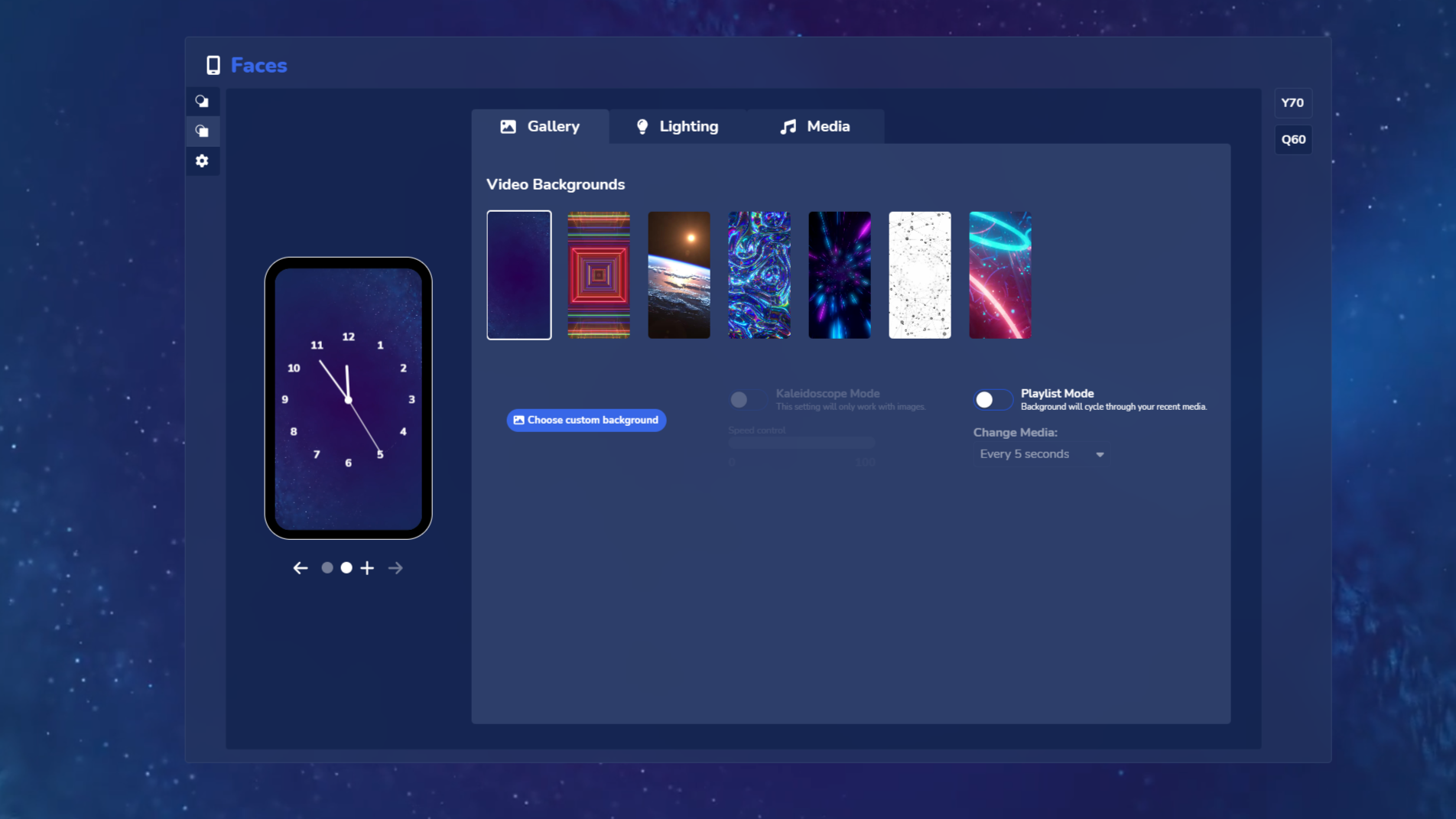

▶ More features promised for the future
Aside from the software features already discussed, Hyte has a variety of features planned for future updates. For example, there’s a plan to let you change the display based on the specific program you’re running.
▶ High-performance 32mm thick 120mm fans
As always, there’s more to a cooler than just the heatsink or radiator. The bundled fans have a significant impact on cooling and noise levels, as well as how the cooler looks in your case.
Like everything else about this cooler, the fans included are thicker than the competition – measuring at 32mm compared to the standard 25mm of other manufacturers. These fans eschew traditional PWM and ARGB connections in favor of a magnetic connection on the side, similar to Corsair’s iCUe Link.
Hyte spared no expense with these fans. Their blades are made of fiberglass-reinforced liquid crystal polymers for enhanced lifespan and rigidity and to support the strong levels of airflow and static pressure possible. Hyte advertises ratings of 105 CFM for airflow and 8.14 mm-H20 static pressure – that’s twice as powerful as the fans used by many competitors.
These fans also include anti-vibration O rings on each corner and even temperature sensors that can be used for the basis of your fan or pump speed if you prefer. Again, Corsair includes temperature sensors in its flagship iCue Link-compatible fans as well. Hyte indicates its confidence in the quality of these fans by backing them with a 6-year warranty.
| Model | 32mm THICC FP12 |
| Dimensions | 120 x 120 x 32mm |
| Fan Speed | Up to 3,000 RPM |
| Air Flow | Up to 105.8 CFM |
| Air Pressure | Up to 8.14 mmH2O |
| Bearing Type | FDB |
| MFFT | 6 Year Warranty |
LGA1700 Socket Bending
There are many factors other than the CPU cooler that can influence your cooling performance, including the case you use and the fans installed in it. A system's motherboard can also influence this, especially if it suffers from bending, which results in poor cooler contact with the CPU.
To prevent bending from impacting our cooling results as we test dozens of coolers on the same platform, we’ve installed Thermalright’s LGA 1700 contact frame into our testing rig. If your motherboard is affected by bending, your thermal results will be worse than those shown below. Not all motherboards are affected equally by this issue. I tested Raptor Lake CPUs in two motherboards. And while one of them showed significant thermal improvements after installing Thermalright’s LGA1700 contact frame, the other motherboard showed no difference in temperatures whatsoever! Check out our review of the contact frame for more information.
Testing methodology
Today's highest-end CPUs, whether Intel or AMD, are difficult to cool in intensive workloads. In the past. reaching 95 degrees Celsius or more on a desktop CPU might have been a cause for concern. But with today’s top-end CPUs, this is considered normal operation. Similar behavior has been present in laptops for years due to cooling limitations in tight spaces.
All testing is performed with a 23 degrees Celsius ambient room temperature. Multiple thermal tests are run on each CPU to test the cooler in a variety of conditions, and acoustic measurements are taken with each result. These tests include:
1. Noise-normalized testing at low noise levels
2. “Out-of-the-box”/default configuration thermal & acoustics testing
a. No power limits enforced
b. Because CPUs hit TJMax in this scenario, the best way to compare cooling strength is by recording the total CPU package power consumption.
3. Thermal & acoustic testing in power-limited scenarios
a. Power limited to 175W to emulate a medium-intensity workload
b. Power limited to 125W to emulate a low-intensity workload
The thermal results included are for 10-minute testing runs. To be sure that was sufficiently long to tax the cooler, we tested both Thermalright’s Assassin X 120 R SE and DeepCool’s LT720 with a 30-minute Cinebench test with Intel’s i9-13900K for both 10 minutes and 30 minutes. The results didn’t change much at all with the longer test: The average clock speeds maintained dropped by 29 MHz on DeepCool’s LT720 and 31 MHz on Thermalright’s Assassin X 120 R SE. That’s an incredibly small 0.6% difference in clock speeds maintained, a margin of error difference that tells us that the 10-minute tests are indeed long enough to properly test the coolers.
Testing configuration – Intel LGA1700 platform

Albert Thomas is a contributor for Tom’s Hardware, primarily covering CPU cooling reviews.
-
NeoMorpheus Always wondered why AIO vendors decided to stay with the 25mm thin radiators.Reply
I’m still rocking an Artic Freezer 120 II AIO which has a 38mm rad and its going strong after almost 5 years.
I remember a custom build in a Cooler Master Elite 120, where the cpu and gpu were cooled with one 120 mm rad, which was also as thick as the one in the article.
And talking about that, would love a mod that uses this rad to cool both the cpu and a gpu. -
Tbonius The cell phone mounted to the thermal block, alone, would be a deal breaker for me. They should sell a version without it, I'm sure it woud be consideraby cheaper.Reply -
Amdlova For me only air coolers... you can find good ones can handle 170 180w for 35/40 bidens.Reply
Got one Sl-100 to cool the ssd and vrm all same time. On a 35w cpu gives 2°c over ambient temps.
And noise? Barely audible at 5cm -
Albert.Thomas Reply
I agree, and I've given them the same feedback.Tbonius said:The cell phone mounted to the thermal block, alone, would be a deal breaker for me. They should sell a version without it, I'm sure it woud be consideraby cheaper. -
mwm2010 I wonder if any SFF builds will use this in the future. I think this is really cool(pun intended).Reply -
LabRat 891 ReplyTbonius said:The cell phone mounted to the thermal block, alone, would be a deal breaker for me. They should sell a version without it, I'm sure it woud be consideraby cheaper.
I'm tempted to tape my Pixel 4a to the top of my (dead/noisy) H100i v2...
"JUST AS GOOD" :LOL: -
thestryker The design of this cooler has been interesting from the start, and I can't imagine it's cheap to produce. While I despise the screen and that would prevent me from buying it I'm not sure how much cheaper removing it would make things. The radiator is still a custom design, has dual pumps and custom fan design while the screen is just a low res 60hz panel. I'd imagine their marketing determined adding the screen would make people more likely to drop that kind of money on an AIO.Reply
I am really glad to see something with a unique design in this market (that also performs extremely well) and hopefully we'll continue to see more. -
crunchylayer4 Would like to see a 140mm wide version. A larger fan at a lower rpm should be slightly quieter. Push-pull fan configurations could also run at lower rpm to maintain similar flow to high rpm fans.Reply -
rockerrb3 We need an exact list of all the cases that will work with this cooler. The NZXT cases seem to be the most popular.Reply -
Albert.Thomas Reply
Well, it kinda depends how you mount it. Hyte expects that most users will front mount the THICC, and its compatible with many cases that way. If you top mount it though, that's where compatibility really is a concern!rockerrb3 said:We need an exact list of all the cases that will work with this cooler. The NZXT cases seem to be the most popular.

